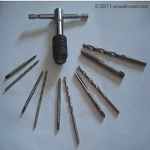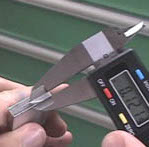Some explanation:
What kind of tap do I need? As explained in the screw guide, coarse threads are much more common, stronger, less likely to jam during installation (cross thread), and faster to install. So, if you’re deciding between coarse and fine threads for a custom hole, use a coarse thread unless you’re going into sheet metal. If you’re trying to make a hole for an unidentified screw, chances are it’s a coarse thread. Metric coarse threads are in between English coarse and fine threads. Metric fine threads are finer than English fine threads and are rarely used.
50% vs 75% tap drill sizes: 100% engagement of a male and female thread means that both threads are fully formed and fully engaged. 50% means that only half of the thread height is engaged, and is what you’d have if you ground off the top half of a fully formed thread. According to the machinery’s handbook, tests have shown that more than 60% thread engagement provides no significant increase in strength. For thread engagements more than 1.5 diameters deep, 50% is usually sufficient. Most taps drill are sized to drill a slightly larger hole than what a 100% thread could be cut into, typically 75% or 50%. More commonly, holes that will create a 75% thread when tapped are used as a margin of safety, and this is what we sell. The downside with drilling a hole that a 100% thread could be tapped into is that it is much more difficult to tap (deeper cuts into the metal), and therefore much more likely to break a tap. We recommend 75% tapping drills unless deep holes in steel are being made.
Clearance holes: A clearance hole is large enough for the screw to slide through without being turned. Many tapping charts will have two types of clearance drills: tight and loose. We list the tight clearance drills and recommend choosing whatever bit is handy and larger than the major diameter for larger clearances–just make sure the screw head or washer is larger. Note that if several holes are being made, the tight clearances don’t leave much room for misaligned holes.
Coarse Threads – English
| tap size (major dia. – threads / inch) |
screw major dia. |
tap drill size for 75% .dia |
tap drill size for 50% .dia |
clearance drill |
|---|---|---|---|---|
| #0-80 | 0.060 | 3/64 (.0469) | 55 (.0520) | 50 (.0700) |
| #1-64 | 0.073 | 53 (.0595) | 1/16 (.0625) | 46 (.0810) |
| #2-56 | 0.086 | 50 (.0700) | 49 (.0730) | 41 (.0960) |
| #3-48 | 0.099 | 47 (.0785) | 44 (.0860) | 35 (.1100) |
| #4-40 | 0.112 | 43 (.0890) | 41 (.0960) | 30 (.1285) |
| #5-40 | 0.125 | 38 (.1015) | 7/64 (.1094) | 29 (.1360) |
| #6-32 | 0.138 | 36 (.1065) | 32 (.1160) | 25 (.1495) |
| #8-32 | 0.164 | 29 (.1360) | 27 (.1440) | 16 (.1770) |
| #10-24 | 0.190 | 25 (.1495) | 20 (.1610) | 7 (.2010) |
| #12-24 | 0.216 | 16 (.1770) | 12 (.1890) | 1 (.2280) |
| 1/4-20 | .2500 | 7 (.2010) | 7/32 (.2188) | H (.2660) |
| 5/16-18 | .3125 | F (.2570) | J (.2770) | Q (.3320) |
| 3/8-16 | .3750 | 5/16 (.3125) | Q (.3320) | X (.3970) |
| 7/16-14 | .4375 | U (.3680) | 25/64 (.3906) | 15/32 (.4687) |
| 1/2-13 | .5000 | 27/64 (.4219) | 29/64 (.4531) | 17/32 (.5312) |
| 9/16-12 | .5625 | 31/64 (.4844) | 33/64 (.5156) | 19/32 (.5938) |
| 5/8-11 | .6250 | 17/32 (.5312) | 9/16 (.5625) | 21/32 (.6562) |
| 3/4-10 | .7500 | 21/32 (.6562) | 11/16 (.6875) | 25/32 (.7812) |
| 7/8-9 | .8750 | 49/64 (.7656) | 51/64 (.7969) | 29/32 (.9062) |
| 1″-8 | 1.000 | 7/8 (.8750) | 59/64 (.9219) | 1-1/32 (1.0313) |
| 1 1/8-7 | 1.1250 | 63/64 (.9844) | 1-1/32 (1.0313) | 1-5/32 (1.1562) |
Fine Threads – Metric
| tap size | major dia. mm (inch) |
tap drill (mm) | tap drill (inch) |
clearance (mm) | clearance inch (dec.) |
|---|---|---|---|---|---|
| M1.6×0.35 | 1.6 (.0630) | 1.25 | #55 | 1.8 | #49 |
| M2x0.4 | 2.0 (.0787) | 1.60 | #52 | 2.4 | #41 |
| M2.5×0.45 | 2.5 (.0984) | 2.05 | #46 | 2.9 | #32 |
| M3x.05 | 3.0 (.1181) | 2.50 | #39 | 3.4 | #29 |
| M3.5×0.6 | 3.5 (.1378) | 2.90 | #32 | 3.9 | #23 |
| M4x0.7 | 4.0 (.1575) | 3.30 | #30 | 4.5 | #16 |
| M5x0.8 | 5.0 (.1969) | 4.20 | #19 | 5.5 | 7/32 |
| M6x1 | 6.0 (.2362) | 5.0 | #8 | 6.6 | G |
| M8x1 | 8.0 (.3150) | 7.0 | J | 9.0 | T |
| M10x1.25 | 10.0 (.3937) | 8.8 | 11/32 | 12.0 | 31/64 |
| M12x1.25 | 12.0 (.4724) | 10.8 | 27/64 | 14.0 | 35/64 |
| M14x1.5 | 14.0 (.5512) | 12.5 | 1/2 | 16.0 | 5/8 |
| M16x1.5 | 16.0 (.6299) | 14.5 | 37/64 | 18.0 | 45/64 |
| M18x1.5 | 18.0 (.7087) | 16.5 | 21/32 | 20.0 | 51/64 |
| M20x1.5 | 20.0 (.7874) | 18.5 | 47/64 | 22.0 | 7/8 |
| M22x1.5 | 22.0 (.8661) | 20.5 | 13/16 | 25.0 | 1 |
| M24x2 | 24.0 (.9449) | 22.0 | 7/8 | 27.0 | 1-5/64 |
| M27x2 | 27.0 (1.0630) | 25.0 | 1 | 30.0 | 1-3/16 |
Fine Threads – English
| tap size (major dia. – threads / inch) |
screw major dia. |
tap drill size for 75% .dia |
tap drill size for 50% .dia |
clearance drill |
|---|---|---|---|---|
| #1-72 | 0.073 | 53 (.0595) | 52 (.0635) | 46 (.0810) |
| #2-64 | 0.086 | 50 (.0700) | 48 (.0760) | 41 (.0960) |
| #3-56 | 0.099 | 45 (.0820) | 43 (.0890) | 35 (.1100) |
| #4-48 | 0.112 | 42 (.0935) | 40 (.0980) | 30 (.1285) |
| #5-44 | 0.125 | 37 (.1040) | 35 (.1100) | 29 (.1360) |
| #6-40 | 0.138 | 33 (.1130) | 31 (.1200) | 25 (.1495) |
| #8-36 | 0.164 | 29 (.1360) | 26 (.1470) | 16 (.1770) |
| #10-32 | 0.190 | 21 (.1590) | 18 (.1695) | 7 (.2010) |
| #12-28 | 0.216 | 14 (.1820) | 10 (.1935) | 1 (.2280) |
| 1/4-28 | .2500 | 3 (.2130) | 1 (.2280) | H (.2660) |
| 5/16-24 | .3125 | I (.2720) | 9/32 (.2812) | Q (.3320) |
| 3/8-24 | .3750 | Q (.3320) | S (.3480) | X (.3970) |
| 7/16-20 | .4375 | 25/64 (.3906) | 13/32 (.4062) | 15/32 (.4687) |
| 1/2-20 | .5000 | 29/64 (.4531) | 15/32 (.4688) | 17/32 (.5312) |
| 9/16-18 | .5625 | 33/64 (.5156) | 17/32 (.5312) | 19/32 (.5938) |
| 5/8-18 | .6250 | 37/64 (.5781) | 19/32 (.5938) | 21/32 (.6562) |
| 3/4-16 | .7500 | 11/16 (.6875) | 45/64 (.7031) | 25/32 (.7812) |
| 7/8-14 | .8750 | 13/16 (.8125) | 53/64 (.8281) | 29/32 (.9062) |
| 1″-12 | 1.000 | 15/16 (.9375) | 61/64 (.9531) | 1-1/32 (1.0313) |
| 1 1/8-12 | 1.1250 | 1-3/64 (1.0469) | 1-5/64 (1.0781) | 1-5/32 (1.1562) |
Coarse Threads – Metric
| tap size | major dia. mm (inch) |
tap drill (mm) | tap drill (inch) |
clearance (mm) | clearance inch (dec.) |
|---|---|---|---|---|---|
| M8x1.25 | 8.0 (.3150) | 6.8 | H | 9.0 | T |
| M10x1.5 | 10.0 (.3937) | 8.5 | R | 12.0 | 31/64 |
| M12x1.75 | 12.0 (.4724) | 10.2 | 13/32 | 14.0 | 35/64 |
| M14x2 | 14.0 (.5512) | 12.0 | 15/32 | 16.0 | 5/8 |
| M16x2 | 16.0 (.6299) | 14.0 | 35/64 | 18.0 | 45/64 |
| M18x2.5 | 18.0 (.7087) | 15.5 | 39/64 | 20.0 | 51/64 |
| M20x2.5 | 20.0 (.7874) | 17.5 | 11/16 | 22.0 | 7/8 |
| M22x2.5 | 22.0 (.8661) | 19.5 | 49/64 | 25.0 | 1 |
| M24x3 | 24.0 (.9449) | 21.0 | 53/64 | 27.0 | 1-5/64 |
| M27x3 | 27.0 (1.0630) | 24.0 | 1 | 15/16 | 1-3/16 |


